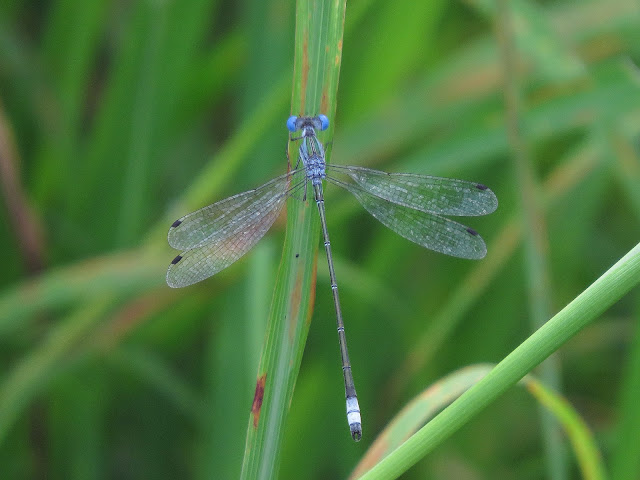This summer here in Ohio we started to get interested in identifying dragonflies and damselflies, so we put some effort into it on our Texas trip, hoping to see some that were new to us. We weren't disappointed! Here is a lovely Rainpool Spreadwing damselfly
and a Desert Firetail, which really lights up lakeside vegetation:
This is a Rambur's Forktail, which was one of the more common damselflies at quiet pond edges:
Watching dragonflies can be a real challenge, since they fly so fast and some rarely stop. Patience is sometimes rewarded, though, and here is a look at two gorgeous dragonflies; the Carmine Skimmer is on top and the similar (and more common) Roseate Skimmer is the lower one.
There was no way that we could resist taking lots of photos of this outrageous Mexican Scarlet-tail that Bill spotted at Bentsen Rio Grande Valley State Park:
Moving up the phylogenetic tree to vertebrates, a few reptiles caught our attention, including this Gulf Coast Ribbon Snake:
At Frontera Audubon Sanctuary we came across this pair of lizards which we were told are Cuban Anoles:
With the mild climate of the valley, it is not unusual for exotic critters to establish large populations. That is the case with the Marine Toad, an amphibian which has been introduced to areas around the world to control pests in agricultural fields. Unfortunately its voracious appetite has lead to declines in native species. This toad was huge--bigger than a softball:
Of course we didn't ignore the birds either, and we saw plenty of cool ones. My two Rio Grande Valley favorites are the Green Jay
and the Great Kiskadee:
The morning chorus of Kiskadees is one of my favorite things about the valley. It just evokes the tropics for me. This link has a recording of its call.
A really exciting highlight of the trip for us was seeing a young bobcat at Estero Llano Grande State Park. Its mother was in the area too but we didn't see her. What a treat it was to be able to photograph this beautiful creature:
Stay tuned for more valley highlights!











What a treat: your blog now has sound! I listened to the kiskadee(s). So… what is the difference between a dragonfly and a damselfly? All the photos and descriptions are great; keep them coming!
ReplyDeleteThanks for you note! Starting at the beginning, damselfly and dragonfly larvae are both aquatic but look very different. Generally adult damselflies hold their wings together behind their backs when at rest (the pictured spreadwing is the exception to that rule!) and dragonflies hold their wings straight out when they are perched. Also, damselflies tend to be much more fragile-looking than dragonflies which are more robust. Both are in the order Odonata so they are pretty closely related.
ReplyDelete